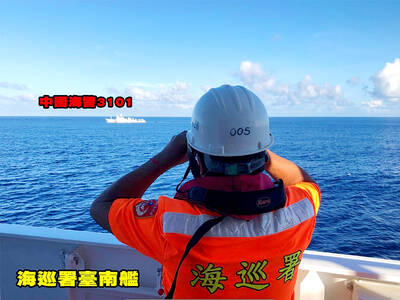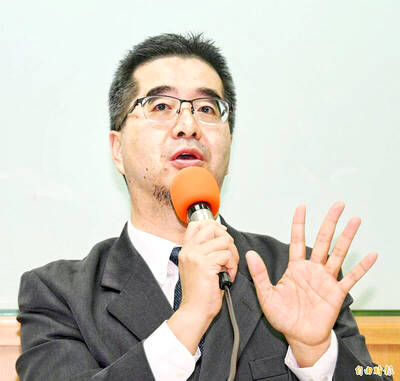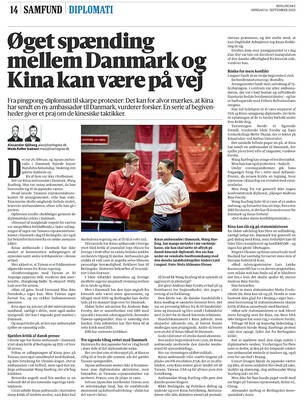A Nantou County Government project to build an incinerator in Mingjian Township (名間) requires public hearings in adjacent administrative areas that could be affected, environmental groups said yesterday, urging the Ministry of Environment to review the project’s environmental impact assessment (EIA) to prevent conflicts of interest.
Democratic Progressive Party Legislator Chen Su-yueh (陳素月) told a news conference that flying ash from the incinerator planned in Mingjian Township would not be confined by administrative boundaries, especially as wind direction changes with the seasons.
The county government has held 10 public hearings in Mingjian Township, but more hearings should be held in neighboring regions as well, including Changhua County’s Ershuei Township (二水), Nantou County’s Jhushan Township (竹山) and Yunlin County’s Linnei Township (林內), Chen said.

Photo: Lo Pei-de, Taipei Times
Residents from Ershuei Township tried to take part in a hearing held in Mingjian Township, but they were expelled and told to “stay out of Nantou County’s business,” she said, calling for transparency in infrastructure development.
Changhua Environmental Protection Union secretary-general Shih Yueh-ying (施月英) said the site chosen for the incinerator is near the Jhuoshuei River (濁水溪) and within 1,200m of Ershuei Township, and could cause more severe pollution in Changhua County than in Nantou County.
The quantity of general trash generated in Nantou County increased by 1.3 percent to 97,959 tonnes last year from 96,630 tonnes in 2022, while the figure in Changhua County dropped to less than 242,536 tonnes from 286,214 tonnes over the same period, down by 15.2 percent, Shih said, citing data from the ministry.
“That shows the Nantou County Government’s passive attitude toward recycling,” she said.
The Changhua County Environmental Protection Bureau enforced waste sorting and trash bag inspections, and reduced the amount of waste generated per person per day in the county by about 20 percent from 2023 to last year, she added.
If Nantou County follows Changhua County’s example by strengthening resource and food waste recycling, its trash that amounts to about 45,000 tonnes could be processed more efficiently and reduced by up to 20,000 tonnes a year, Shih said.
All the existing or planned incinerators and solid recovered fuel facilities in Taiwan would provide an additional waste processing capacity of 2.22 million tonnes per year, she said, adding that Mingjian Township’s incinerator project is not necessary.
Chuang Li-te (莊理德), spokesman for the Mingjian Township Anti-Incinerator Self-Help Group, said that an incinerator is not suitable for Mingjian Township, as the region is a major production area of tea and leafy vegetables, which could be contaminated by heavy metals or dioxins from the incinerator.
The incinerator would also form a waste disposal industrial chain and attract illegal disposal of waste, which could undermine Nantou County’s natural resources as the local environment bureau’s inspection capacity is insufficient, he said.
Mingjian Township Mayor Chen Han-li (陳翰立) said the project’s EIA was restricted to the township’s Xinmin Village (新民), where the incinerator is to be constructed, but actually the whole of Baguashan (八卦山) would be heavily affected by the incinerator’s ash.
More than 200 protest banners against the project hung around the township were removed by the Nantou County Environmental Protection Bureau and Chen Han-li was fined NT$18,000 on charges of contravention of the Waste Disposal Act (廢棄物清理法), he said.
“We have the right to protest as a citizen living in a free and democratic society, but [the Nantou County Government] removed all the banners and reported me to the local administrative enforcement authority,” Chen Han-li said.
The Nantou County Government also paid “special attention” to local residents who voiced dissent at hearings by taking photographs of them, he said.
Taiwan Watch Institute secretary-general Herlin Hsieh (謝和霖) said the EIA committee’s experts responsible for reviewing the project were hired by the Nantou County Government and have conflicts of interest.
Therefore, the EIA should be reviewed by the ministry or representatives recommended by Mingjian Township instead, he said.
In response, the ministry said that incinerator construction should conduct a two-phase EIA and would have to inform adjacent administrative areas about the project in the EIA’s second phase.
Public hearings would also be held in the second phase as required by law, it said, adding that the ministry would encourage the Nantou County Government to hold hearings in adjacent administrative areas.

The Coast Guard Administration (CGA) yesterday said it had deployed patrol vessels to expel a China Coast Guard ship and a Chinese fishing boat near Pratas Island (Dongsha Island, 東沙群島) in the South China Sea. The China Coast Guard vessel was 28 nautical miles (52km) northeast of Pratas at 6:15am on Thursday, approaching the island’s restricted waters, which extend 24 nautical miles from its shoreline, the CGA’s Dongsha-Nansha Branch said in a statement. The Tainan, a 2,000-tonne cutter, was deployed by the CGA to shadow the Chinese ship, which left the area at 2:39pm on Friday, the statement said. At 6:31pm on Friday,

The Chinese People’s Liberation Army Navy’s (PLAN) third aircraft carrier, the Fujian, would pose a steep challenge to Taiwan’s ability to defend itself against a full-scale invasion, a defense expert said yesterday. Institute of National Defense and Security Research analyst Chieh Chung (揭仲) made the comment hours after the PLAN confirmed the carrier recently passed through the Taiwan Strait to conduct “scientific research tests and training missions” in the South China Sea. China has two carriers in operation — the Liaoning and the Shandong — with the Fujian undergoing sea trials. Although the PLAN needs time to train the Fujian’s air wing and

The American Institute in Taiwan (AIT) put Taiwan in danger, Ma Ying-jeou Foundation director Hsiao Hsu-tsen (蕭旭岑) said yesterday, hours after the de facto US embassy said that Beijing had misinterpreted World War II-era documents to isolate Taiwan. The AIT’s comments harmed the Republic of China’s (ROC) national interests and contradicted a part of the “six assurances” stipulating that the US would not change its official position on Taiwan’s sovereignty, Hsiao said. The “six assurances,” which were given by then-US president Ronald Reagan to Taiwan in 1982, say that Washington would not set a date for ending arm sales to Taiwan, consult

A Taiwanese academic yesterday said that Chinese Ambassador to Denmark Wang Xuefeng (王雪峰) disrespected Denmark and Japan when he earlier this year allegedly asked Japan’s embassy to make Taiwan’s representatives leave an event in Copenhagen. The Danish-language Berlingske on Sunday reported the incident in an article with the headline “The emperor’s birthday ended in drama in Copenhagen: More conflict may be on the way between Denmark and China.” It said that on Feb. 26, the Japanese embassy in Denmark held an event for Japanese Emperor Naruhito’s birthday, with about 200 guests in attendance, including representatives from Taiwan. After addressing the Japanese hosts, Wang